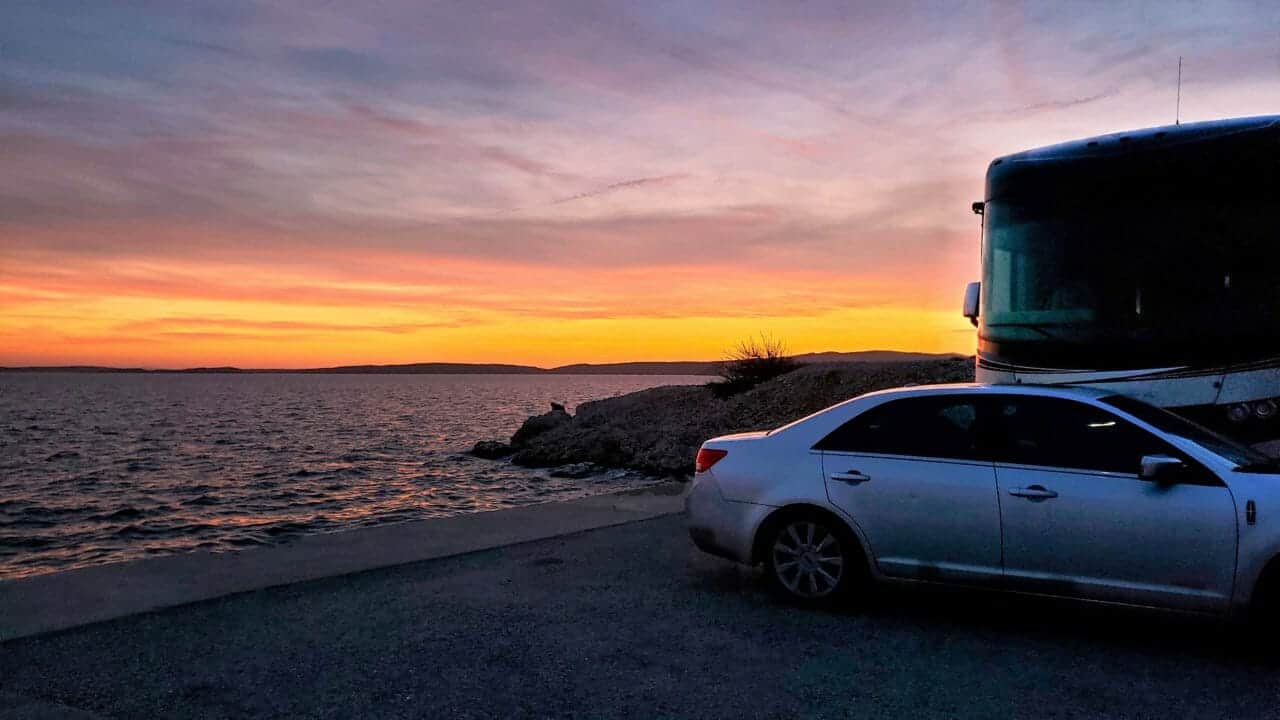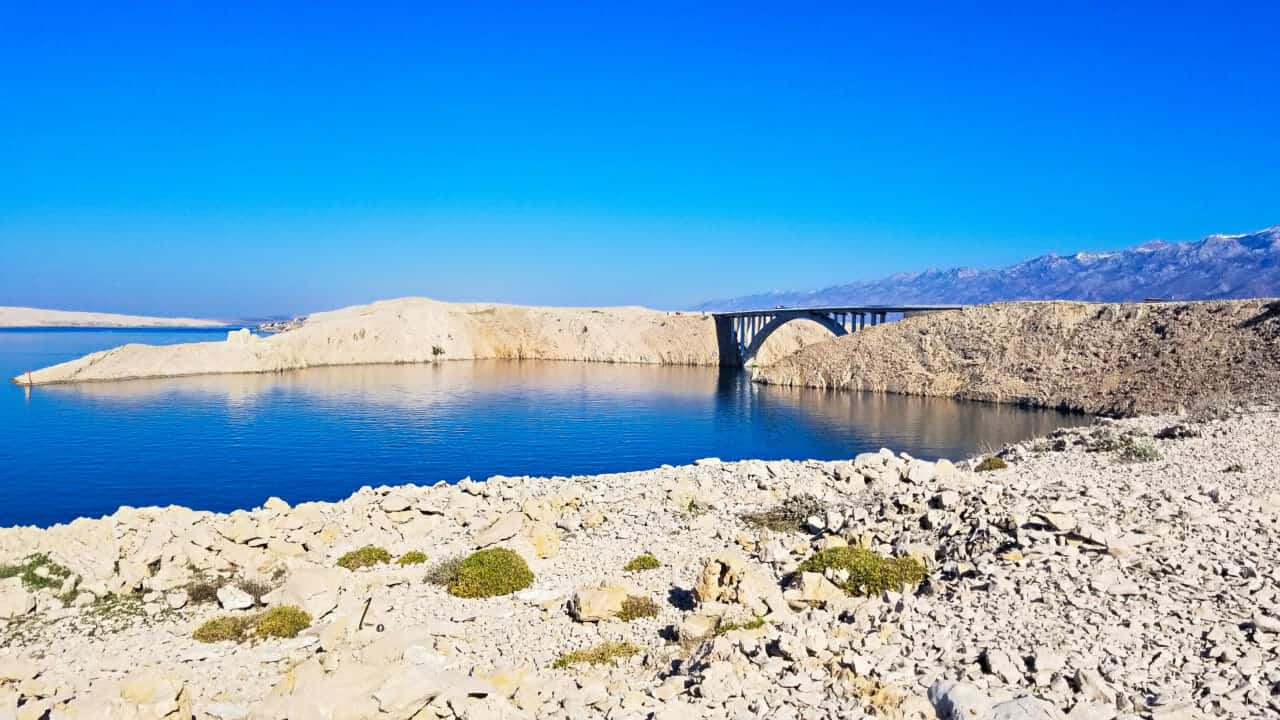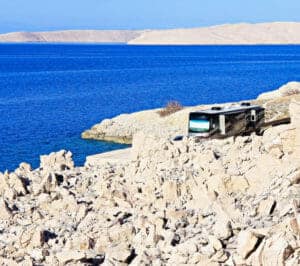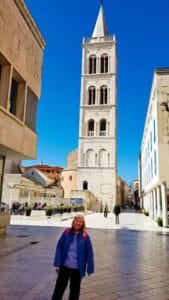Island of Pag

Mike and I are staying next to the Island of Pag. It is the 5th largest island in Croatia and it has the longest coastline. Mike of course, just had to drive from one end of Pag to the extreme other end, even knowing that there wasn’t anything out there. The island is very unusual looking. Mike said that, based on the landscape, he felt like we were on the moon. I guess he isn’t the only one that feels that way. According to the internet, Pag is “known for its barren, moonlike landscape”. Mind you, that is probably more Hollywood than reality. The scenery is much more interesting than it sounds. From a distance the rocky hills look quite smooth and you have these smooth, uncovered hills flowing right down into the sea. Where we are staying it is very rocky making it tricky to walk around the water’s edge.
We are really happy with where we are parked. The internet is so helpful for travellers these days. We are camping on an old ferry dock/parking area that is very well hidden. It is now used by a few fishermen to park their cars. As you can see from the top picture we look out over water and hills in the distance and get to see gorgeous sunsets every night. The picture here makes it look like we are camping in the middle of nothing but rocks. It just goes to show how deceptive camera angles can be. You are not allowed to wild camp or camp outside an official campground in Croatia. You can understand that rule because of the number of tourists they get in prime season. Since we are in the “off season”, we were hoping that we would be OK. On our second evening a police car arrived and stopped in front of the RV. We were a little concerned. It turned out that the police were just doing some scuba diving. When they finished, they looked at our RV just like everyone does and then they left. This made us feel much more comfortable about parking in this lovely spot.
The dock is about 8 feet (2 ½ m) above the water, and we were parked about 15 feet (4 ½ m) from the edge. At about 6 PM one evening we met a fisherman who told us that we should move further back, or our RV was going to get soaked with salt water as the wind picked up. We moved back about 30 feet or 10 metres. Another fisherman was just arriving, and he said that we probably weren’t far enough away and that the winds were predicted to last for three days. We listened and moved. The winds were quite strong at night and at 5 AM one morning, Mike got up, turned on the generator and brought the living room walls in so that the small awnings above the slide outs didn’t rip and the RV didn’t get so buffeted. Although the days were blustery and quite windy, they were nothing like the winds that the Croatians talk about all the time. We have heard about the Bura winds (sometimes called Bora winds in English) from many locals from the time we first got to Croatia.
Croatia has two main winds, the Bura and the Jugo. Bura is the one you hear about all the time. Croatians seem to have a love/hate relationship with this wind. When Mike and I were looking for somewhere to store our RV over the winter, we were told that we wouldn’t have much problems with snow or ice, but we did have to be concerned about a Bura blowing through the campground and causing broken branches or falling trees. Last week we camped near a small mall on the Island of Krk. The mall had a fair-sized square entrance or lobby. The three outside entrance walls each had a large double glass door. Only one of these doors was open on a given day. Mike’s guess is that they had to consider the winds and wind direction when they built the mall. In a different area we stopped in one café where the owner told us that during a Bura he closes down the café. It is that scary and extremely cold and definitely gets the locals respect. Mike and I just missed being caught in a nasty Bura one month ago. Luckily, we were still in northern Croatia, in a protected bay area. Winds of 176 km/h were measured in Split where we will be shortly. These winds caused parts of the highway to be shut for traffic, cancelled ferry connections to the islands, uprooted and snapped large trees and caused other devastation to cars and property as roofs and debris was sent flying. To see a short video from last month click here. We have been driving around Zadar, which is a city on the coast heading towards Split. Many of the fields have very large branches broken, and trees uprooted. The damage to the trees looks fresh so we think this must have been from the Bura just a month ago. All of this encouraged me to do some more checking on the internet which I did. The information below is combined from multiple sources and comments from people we met.
The Bura comes from the north and typically blows for three days although it can last for a week. It’s most common in winter but can happen at any time of the year. Along the coast in Croatia, the sky can get clogged with a haze that makes the islands barely visible. Bura comes in and wipes the sky clean. Bura has been clocked as high as 304 km (189 miles) per hour. We are talking hurricane force icy cold winds. Luckily homes here are built of stone, brick, or concrete and not wood. According to the internet Bura is considered clean and healthy. Bura is supposed to clean everything. It cleans the air, the ground, the sea. People simply feel good, their minds are cleared. As long as it stays below hurricane grade winds the area is a much cleaner, healthier and better place when Bura comes to town.
The incredible flavor and saltiness of the world-famous cheese from Pag Island, where we are now, is also attributed to Bura. As the wind kicks up, it blows the salt from the Adriatic Sea onto the island grass. The sheep graze on the salty grass and herbs, which makes their milk supremely tasty for cheese preparation. I must admit that Mike and I haven’t tried the cheese yet. Because of its position on the coast, Bura can blow in multiple directions. During the Eastern European Cold Wave in the winter of 2012, the Bura threw fish out of the sea here on the island of Pag.

If people respect Bura they don’t appear to like Jugo and they don’t talk much about Jugo. Jugo is a moist wind from the south, typically accompanied by dark clouds and rain-filled storms which can create big waves. All of this affects the mood, and since Jugo usually lasts a long time it can cause depression, body aches, pains and grumpiness. Jugo is always an acceptable excuse for melancholic behavior. Its negative influence on people is so notorious that during the Republic of Dubrovnik (14-19th century) the Jugo was considered a legal defense and authorities were lenient towards criminals who committed crimes while Jugo was blowing.
The words Bura and Jugo have become colloquialisms. Bura is used for cleaning things, the wind is known as the “cleaning lady”. Jugo can be used as a synonym for bad or inconvenient. For instance, you could say, “This sandwich is really jugo” or “I hope I don’t miss my bus, that would be jugo”. Just some interesting trivia.
We aren’t getting the bike riding in that we had hoped for, with hills and mountains going down to the sea it is just too hilly and steep, even for our electric bikes. In addition, the wind has been quite cool these last few days and the roads are narrow with no bike paths.
Last year Mike and I visited Zadar during a really hot period. Not my favourite time to explore. This year it has been lovely wandering around. One couple saw the Canadian flag on my knapsack and came over to talk with us. They said that they were our neighbours from Quebec. Funnily enough, Mike had actually said hi to this same couple in a gas station a week ago in a completely different area. Zadar is an interesting town whose origins are older than Rome.
This afternoon we walked around the town of Nin. Last year we camped within walking distance of Nin and actually attended an outdoor concert in the shadow of buildings built in the Roman era.
For our friends, Mike and I are using Google Duo to communicate with our family. It is basically a Skype competitor. It is an easy, no charge, video conferencing app that even my non-technical mother uses to call us. We would really like to see more of our friends using this to contact us. The best times to get hold of us are from 11 AM to 5 PM in Toronto or New York ET. I always thought that if we didn’t have great internet it was better to use voice without video. I was wrong. Somehow, you can put up with worse quality problems when you can actually see the other person and yes, I am sure that many of you already know this. I didn’t. We really like it and have our 18” tablet turned on every evening so we can use it to answer calls on a big screen. An obvious great benefit is that the calls are free from everywhere over the internet. Yes Jan, you can call me using Wi-Fi from your cruise ship.
We expect to leave this lovely spot tomorrow and head to a campground near Krka National Park where we plan on doing some hiking (walking). We have been here 6 nights with no problems with fuel or water. We are getting good at this dry/wild camping. As we get to the high tourist areas like Split and Dubrovnik and as it gets closer to the summer our wild camping in Croatia will probably have to come to an end.




Leave a Reply